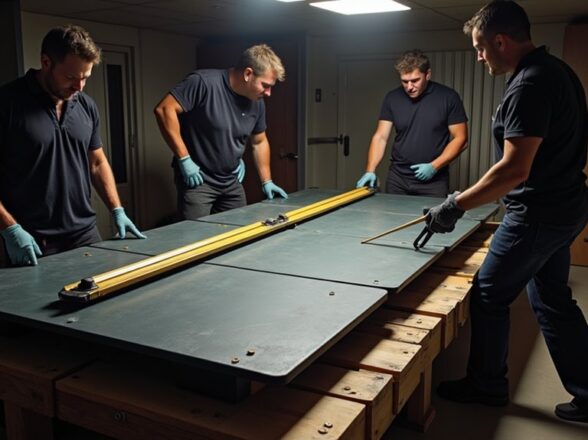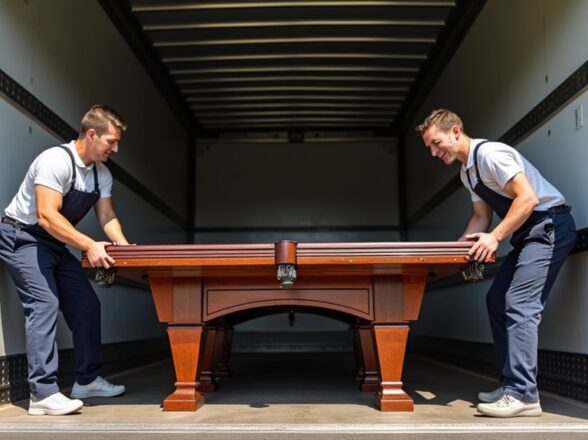What Are the Best Packing Materials for Moving Art and Antiques? Must-Have Supplies for Safe Transportation

To safely transport art and antiques, you need high-quality packing materials. Use sturdy boxes in various sizes, including specialty boxes for fragile items. Wrap delicate pieces in multiple layers of bubble wrap, guaranteeing the bubbles face inward. Packing paper and foam sheets provide necessary cushioning. After wrapping, secure items with masking tape but avoid sticking tape directly on the items. Add extra protection with corner protectors and moving blankets. Label all boxes as "Fragile" and "This Side Up." Following these guidelines helps prevent damage during your move. There's more helpful information to guarantee your items arrive safely.
Importance of Proper Packing

When it comes to moving art and antiques, proper packing isn’t just important—it’s essential. You need to focus on properly packaging your valuable items to guarantee they arrive safely. For fragile antiques, using high-quality packing materials is vital. These include sturdy boxes and bubble wrap, which provide a shock-absorbing layer. This helps prevent scratches, cracks, and breaks during transportation. Adequate protection is key, so always label your boxes with instructions like “Fragile” and “This Side Up. ” This greatly reduces the risk of mishandling by movers. Additionally, document the condition of each item with photographs before packing. This will help with claims in case of damage and aid in maintaining the item’s value throughout the move. For exceptionally delicate items, consider using climate-controlled storage solutions to ensure the environment is optimal for preserving their integrity during the move. Follow these expert tips for the best results. Moreover, it’s crucial to research and choose the best storage solutions for art if you need to temporarily house your pieces during the moving process. Look for facilities that offer climate control and security, as this will guarantee a safer environment for your valuable items. Always ensure to keep an inventory list of what you’ve stored, along with any special instructions that might be needed for handling these treasures.
Essential Packing Supplies
Packing art and antiques requires the right supplies to guarantee your treasures remain safe during transit. Using high-quality boxes in various sizes is essential, especially specialty boxes for fragile items. Bubble wrap is crucial; wrap fragile items in multiple layers to absorb shocks. Packing paper and foam sheets protect surfaces and cushion items. Consider investing in specialized insurance to cover accidental damage during transport and packing.
Here's a quick reference table for essential packing supplies:
| Packing Supplies | Purpose | Notes |
|---|---|---|
| High-quality boxes | Secure packing of items | Specialty boxes needed |
| Bubble wrap | Absorbs shocks for fragile items | Use multiple layers |
| Packing peanuts | Fills empty spaces in boxes | Prevents movement |
Don't forget masking tape, moving blankets, and corner protectors for added safety.
Techniques for Wrapping Items

Wrapping items properly is essential to protecting your art and antiques during a move. Start the wrapping process with packing paper or foam to create a protective layer. Cover all edges and corners thoroughly to prevent damage. For fragile items, use multiple layers of bubble wrap with the bubbles facing inward to absorb shocks effectively. Secure everything in place with masking tape, but avoid taping directly on the items. Consider double boxing for glass items by placing the wrapped piece in a smaller box, then putting that box inside a larger one filled with cushioning material. Finally, fill any empty spaces in moving boxes with packing peanuts or crumpled paper for a snug fit, preventing shifting during transit. When choosing a moving service, opt for expert handling to ensure your valuables are transported with precision and care.
Benefits of Professional Movers
Choosing professional movers can make all the difference in ensuring your art and antiques are transported safely. These experts have specialized training in handling delicate items, greatly reducing damage risks. They provide an extra layer of security with insurance coverage for valuable pieces, giving you peace of mind during the move. Professional movers offer specialized packing materials that are high-quality and tailored specifically for different types of items, ensuring maximum protection during transportation. Here are some key benefits of hiring professional movers:
- Custom packing solutions for fragile antiques, ensuring they're properly protected.
- Experienced collectors can trust these movers to understand the nuances of the packing process.
- Moving companies offer additional insurance options that reflect the true value of your high-end art.
With their expertise, you can focus on other aspects of your move while your belongings are in capable hands.
Common Packing Mistakes to Avoid

While it's easy to get caught up in the excitement of moving, overlooking common packing mistakes can lead to costly damages. One major error is overpacking boxes, which can cause fragile items to break during transport. Always use high-quality packing materials that can withstand the rigors of a moving truck. Underestimating the amount of packing material, like bubble wrap, can leave your items inadequately protected. Additionally, neglecting to label boxes can create confusion during unpacking. Clearly marking each box with contents and handling instructions is crucial to prevent damage. Finally, don't forget to create an inventory list of all items being moved. This guarantees you track their condition and assures nothing is lost in the process.
Frequently Asked Questions
What Is the Best Packing Material for Moving?
"An ounce of prevention's worth a pound of cure." When moving, use sturdy moving boxes, bubble wrap for fragile items, cushioning materials, and protective blankets. A labeling system and packing tape guarantee everything stays organized and secure.
How Do You Pack Art Supplies for Moving?
When packing art supplies, use sturdy cardboard boxes and bubble wrap for fragile items. Implement a labeling system, create an inventory checklist, and secure everything with packing tape for organized, safe transport. Don't forget protective covers!
How Do You Pack an Antique?
Did you know 70% of antiques suffer damage during moves? For antique care, use protective padding like bubble wrap and wooden crates, create an inventory checklist, and follow transportation tips for delicate items to guarantee safe unpacking. Additionally, it’s advisable to consider reaching out to professionals, especially for high-value items, as they possess expertise in handling and moving delicate antiques. Fine art transportation services can provide an extra layer of protection through specialized packing and climate-controlled environments. By investing in these services, you can ensure that your cherished pieces arrive at their destination in pristine condition. Moreover, when dealing with international moves, it’s crucial to understand customs regulations and any necessary permits for transporting antiques across borders. Researching how to transport art internationally can help you navigate the complexities of shipping, ensuring compliance with laws and avoiding potential delays. Ultimately, taking these precautionary measures will safeguard your investments and allow you to enjoy your treasured pieces for years to come.
What Is the Best Way to Pack Framed Art for Moving?
When packing framed art, use bubble wrap and corner protectors for added security. Place them in sturdy cardboard boxes with protective layers. Consider climate control during transportation and invest in art insurance for extra peace of mind.
Conclusion
Packing art and antiques carefully is essential to guarantee they arrive safely at their destination. By using the right materials and techniques, you can avoid damage and loss. Coincidentally, investing time in proper packing can save you from potential heartache later. Whether you choose to do it yourself or hire professionals, being mindful of your approach matters. In the end, a little preparation goes a long way in protecting your valuable items during a move.
Related posts
Recent posts
Post Categories
Tags
Subscribe







